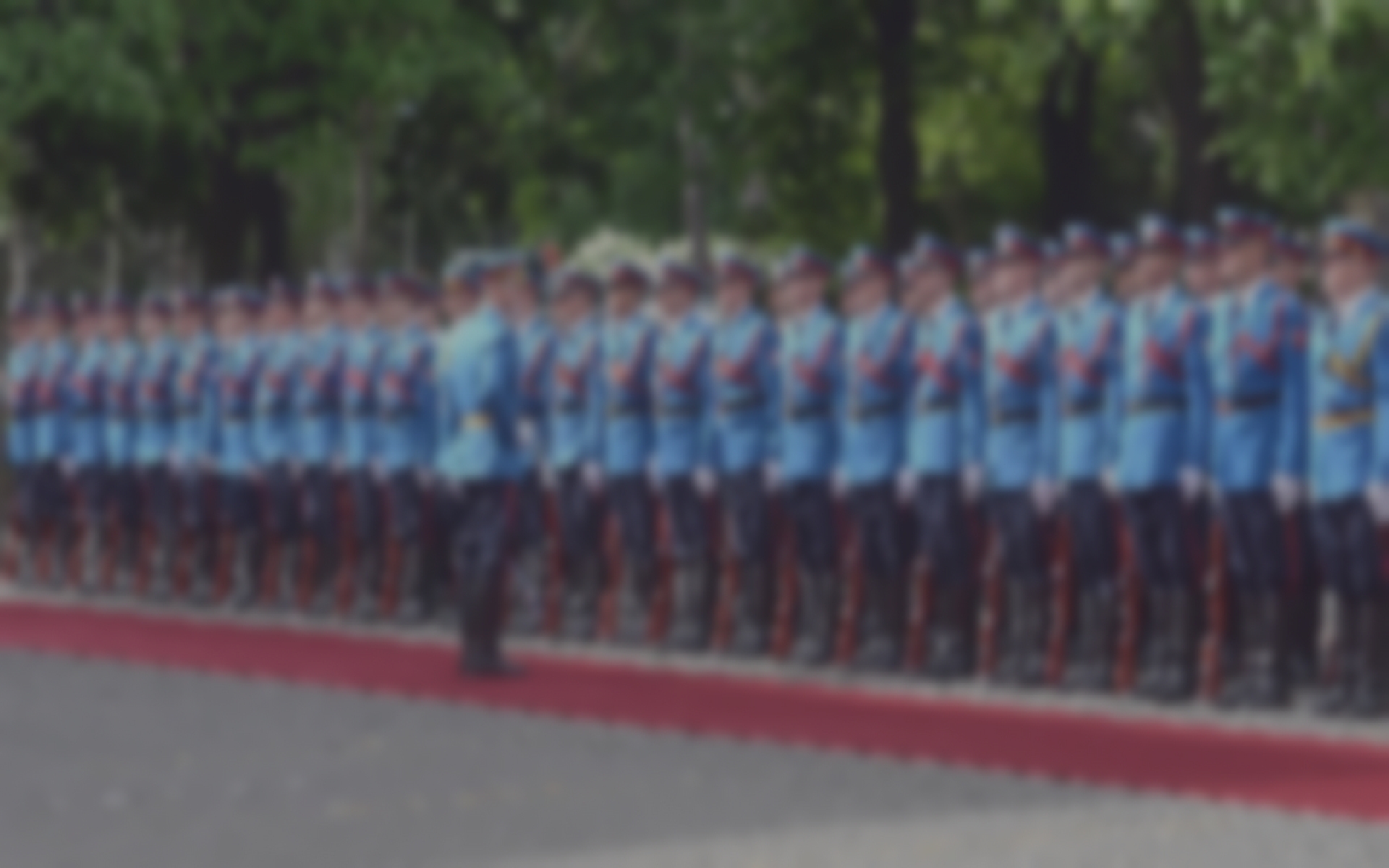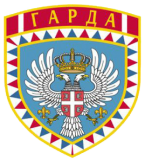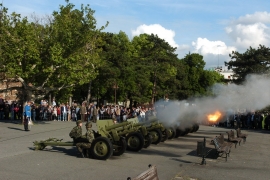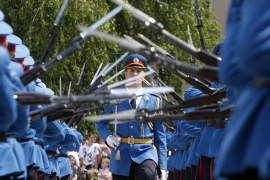SAF Guard
The Guard is a brigade level unit of the Serbian Armed Forces, which is directly subordinated to the Serbian Armed Forces Chief of General Staff. It is responsible for safeguarding the facilities of vital importance for the defence system and giving military honours to the top foreign, state and military officials.
- SAF GuardCommander, SAF Guard, Major General Željko Furundžić
- HQ Battalion
- Guard Battalion
- 25th MP Battalion
- Logistic Battalion
- Special-purpose Compounds
- Residential Compounds
The Guard also performs activities falling within the remit of the Military Police and tasks of providing logistic support to the Ministry of Defence and Serbian Armed Forces.
The Serbian Armed Forces Guard Commander is Major General Željko Furundžić.
Tasks of the Guard
Tasks which are executed by the Guard arise from its purpose:
- Immediate organization and task execution of giving military honours within the protocol of the state bodies,
- Safeguarding the facilities, movable assets and people,
- Logistic support of MoD and SAF organizational units,
- Maintenance and installation of the command post facilities in wartime,
- Providing telecommunications to certain persons when they are in the facilities of vital importance for the Serbian Armed Forces and the defence system of Serbia, and if it is necessary also in other facilities,
- Training of commands and units for task execution and reaching the required standards of training,
- Organization and realization of representative services in the Guard representative objects,
- Engagement of the Guard forces or some Guard units is done by the order of the Chief of General Staff.
Background of the Guard
At the beginning of 1830, Milos Obrenovic, the Prince of Serbia, addressed the administrative center chiefs, asking “to pick the best young men for his Guard from wealthy houses, judging from their status and reputation.”
Selecting them from the common soldiers, the Prince set criteria for the selection of Guardsmen: “Each of them has to be healthy, single and in every sense of appropriate conduct, non-alcoholics, and not to be popinjays and if it is possible, literate.”
The Prince addressed the future guardsmen’s parents: “Every father or relative has to be proud of his son or relative who has become a member of the Guard.”
On St. George’s Day 1830, in Pozarevac, an infantry company was made up of 73 outstanding young men selected from the first group, and all of them were enrolled in the Guard school to become literate and get military training.
Later, after establishing the second Guard Company, the Guard was merged into the Guard Squad and “the main military chief (serdar) and the chief of the Prince’s Guard, Toma Vucic Perisic, was appointed. Later, the Guard moved to Kragujevac, which used to be the capital of the Principality of Serbia.
In spring 1831, “The Serbian Prince Orchestra” became a part of the Prince’s Guard. The chief of the Orchestra was a bandmaster Josip Slezinger who was sent to Kragujevac by his brother Jevrem, the chief of the Sabac administrative center, all together with his band and instruments to serve Prince Milos.
On the Orthodox holiday of Candlemas (Sretenje) in 1835 in the Cathedral in Kragujevac, the new Constitution pontificated by the clergy was officially proclaimed, and Jevrem Gavrilovic was an honor guardsman who carried the flag.
Three years later, on 12th May 1838, the establishment of the Guard was legalized by the adoption of the Prince Milos Obrenovic decree. For the first time, the Guard received its official military insignia and since then, that date has been embroidered with the gold thread on the three-coloured strip at the top of the spear of the Guard flag.
During his reign for the second time in Serbia, in 1861, Prince Milos Obrenovic decided that his guardsmen would wear “dusanke”, lavishly decorated uniforms, modeled according to the Hungarian uniforms, but in compliance with clothing customs of Medieval Serbian clothes.
On Palm Sunday (Serbian Cveti) in 1886, at a grand ceremony in Belgrade, which was organized in the Upper-town at Kalemegdan Fortress, King Milan Obrenovic gave military flags to fifteen commanders of infantry regiments, five commanders of cavalry regiments, as well as to Captain 2nd class Mihajlo Kumrijic, the commander of the Guard squadron. Then the gun salutes of the Guard company were fired and the King said: “Handing over the flags to you today, I give you honor. I give you dignity and the future of Serbia.”
“Long live the King, Fatherland and Faith – the Royal Guard” was embroidered with a gold thread on the Royal Guard flag.
The Guard was a remarkable symbol of the armed forces, and at the coronation of King Peter Karadjordjevic in September 1904, and in tough times of World War I, the Guard was not only his immediate protection, but also moral support and combat inspiration.
During the withdrawal of the troops toward Greece in winter 1915 and 1916, the guardsmen carried the old King across the Albanian gorges. Many of them died during that trip. In the days of Thessaloniki victorious offensive, assault, and liberation of the homeland in 1918, many of the guardsmen gave their lives.
At the beginning of World War II, the Royal Yugoslav Armed Forces were unprepared, insufficiently powerful and determined to respond to the threats of the Axis powers. The majority of the non-Serbian armed forces members deserted or surrendered at the first contact with the enemy. Weakened by the internal strife and betrayal, the Royal Yugoslav Armed Forces were not able to resist the occupying forces for a long time.
Upon the end of the April War, a large number of mainly Serbian soldiers and officers, who refused to surrender, were taken to prison. The Royal Guard suffered the same fate. Some of them who were not taken to prison by the occupying forces, continued to resist the enemy. A certain number of officers joined the movement of the Yugoslav Armed Forces, within which the Mountain Guard of his Majesty King Peter II Karadjordjevic was established.
On the other hand, within the General Staff of the People’s Liberation Front of Yugoslav Partisan detachments, staff support units were formed, starting from the sentry and support platoon, then the support company, to the staff support battalion, with more than 600 soldiers, of whom nearly 100 were killed in war operations. Eight battalion members were declared the National heroes.
At the end of the war, by the decision of the Commander of the People’s Liberation Front of Yugoslavia, Josip Broz Tito, on 1st November 1944 the Guard Brigade of the People’s Liberation Armed Forces General Staff and Yugoslav Partisan detachments was established, and the commander was Lieutenant Colonel Milan Zezelj.
In May 1945, the Guard Brigade got its orchestra of 77 musicians. The first post-war military honor was given to British Field Marshal Harold Alexander, the commander of Mediterranean Allied Forces.
In 1946, the Guard Brigade grew into a division, and in March 1948, the Guard Division was transformed into the Yugoslav Armed Forces Guard Command with regional responsibilities, whose commander was Major General Milan Zezelj. Apart from other units, the Guard consisted of the Navy Detachment on Brioni Island and the Guard Fleet Detachment on the Danube River. That kind of organizational structure remained until 1953. At the same time, it was the highest rank formation in the history of the Guard units in our region.
In July 1954, the Yugoslav Guard got new uniforms which had light blue military jackets to give military honours to the Ethiopian Emperor Haile Selassie. Those uniforms have been a recognizable feature of the Guard for more than half a century.
The flag has been used since 1954, when on the 1st September, it was awarded to the 118th Special Brigade at the ceremony held at the Airport in Zemun. This flag, with gold embroidered red star and the slogan of the Proletarian International, was used when the Guard was giving military honors until the disintegration of Yugoslavia, i.e., until 1992.
In order to protect the Constitution of the Socialist Federal Republic of Yugoslavia, by the Supreme Command order, in 1991 the Guard Brigade was engaged in counterinsurgency and paramilitary operations with a huge death toll. A large number of officers, NCOs, soldiers and volunteers were killed during combat operations, diligently and professionally executing the assigned tasks, and it is documented by papers and exhibits as the testimony on the Wall of Remembrance in the Guard memorial room.
During 1999, 8 soldiers, members of the Guard, were killed defending their fatherland from NATO aggression.
The unit was awarded:
- Order of the White Eagle, 5th class – 6th May 1898
- Order of the People's Hero – 3rd July 1958
- Order of Brotherhood and Unity with Golden Wreath – 2nd November 1975
- Order of Merit for people with Golden star – 3rd November 1980
- Order of the War Banner, 1st class – 6th May 2000
- Order of the White Eagle, 2nd Class – 6th May 2015
- Order of Saint Simeon the Myrrh-Giver – 12th October 2020
The guardsmen who were killed serving their country were credited for all these awards and the current Guard’s image.
The present Guard came into existence through the transformation of the Guard Brigade to the SAF Guard on 30th November 2006 by the Decree of the President of the Republic of Serbia. At the ceremony held on that occasion, the commander Colonel Goran Radovanovic received a military flag of the unit.
Contact Information
Address: Jovana Marinovića St., Belgrade
Phone: +381 (0) 11 2064-005
Fax: +381 (0) 11 3005-410
Email: garda@vs.rs





